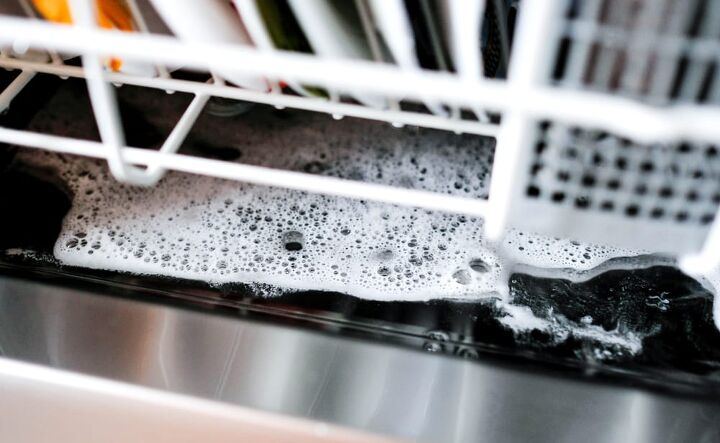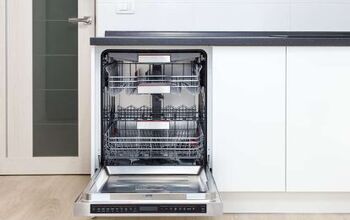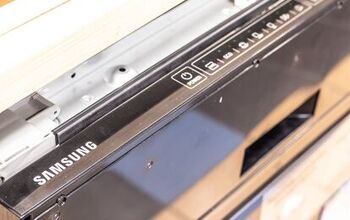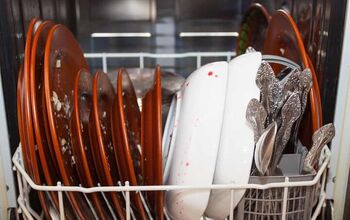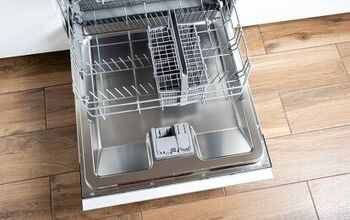Got Water In The Bottom Of The Dishwasher? (We Have A Fix!)

If there is still water in the bottom of your dishwasher after it is done running, don’t freak out. There are ways to fix it. And it is often a minor issue that you can fix yourself.
If there’s water in the bottom of the dishwasher it could be because of a dirty filter or drain basket, clogs in the drain hose, a blocked drain, or a closed-off air gap. It could also be from issues with your garbage disposal, the float assembly, pump motor, or timer. Many issues are easily fixable, but some require a plumber.
We will start with the most common and work our way to the very rare. So, get a few towels and a large cup and get rid of the water so you can see what may be causing the problem.
Do You Need Appliance Repair Services?
Get free, zero-commitment quotes from pro contractors near you.

Top Reasons There’s Water In The Bottom Of The Dishwasher
Here’s a look at the reasons your dishwasher is holding water in the bottom. Some problems you can fix yourself with minimal effort, but others will be a bit more complex. If anything starts to sound a bit outside your comfort zone, make sure to have your plumber’s phone number handy.
One thing that’s worth trying before you start rolling up your sleeves is to try running the dishwasher for another cycle. Someone might have bumped it while it was running and accidentally turned it off before it was finished.
If that is the case, running it again should finish the cycle and drain the tub. If not, keep reading. Make sure to get the water out of the bottom dishwasher first to complete your assessment.
You can scoop it out with a cup, then soak up the rest with a large sponge. Make sure to lay out towels on the floor in front of your dishwasher before proceeding to avoid making a mess.
1. A Clogged Filter Basket
Dishwashers have a filter basket in the drain at the bottom of the dishwasher tub. The basket stops food particles and other debris from getting into the pipes.
However, when too much food and junk get lodged in there, it will not let the water drain. Therefore, clean this it’s a good idea to periodically clean the filter basket anyway. Some dishwasher models feature self-cleaning filters, you can check your manual to know for sure.
Cleaning out the filter basket is an easy DIY task that should become part of your regular dishwasher maintenance routine. To clean it, follow these steps.
- Turn off or unplug the dishwasher. You can also shut off the power at the circuit breaker. Whichever is easier for you to do.
- Find the filter basket located around the filler arm at the bottom of your dishwasher
- If your filter basket is removable, take it out and empty the debris. Give it a good washing in hot water to clean it completely before you put it back.
- If the filter basket is not removable, you will have to clean it out with your hands. Remove as much of the debris as you can.
- Use a clean cloth to remove any gunk or grime on the surface of the filter basket.
- Plug the dishwasher back in and see run another cycle.
2. A Clogged Drain Can Lead To Water In The Bottom Of The Dishwasher
If the basket was not the issue, the clog might be underneath the basket, in the drain itself. The drain valve could be stuck. Make sure it moves freely and nothing is blocking it.
Alternatively, the sump under the drain basket might be full of sludge or other stuff that should not have made it through the basket. If this gums up the works and blocks the drain, the water won’t have anywhere to go. The result is standing water in the bottom of your dishwasher.
To check the drain below the basket and clean it out if necessary, follow these steps:
- Unplug the dishwasher or turn off the breaker.
- Try using a skinny piece of metal to see if you can unclog it by poking through the basket holes.
- If that did not work, unscrew the nuts to get to the sump underneath.
- Dislodge anything that is blocking the sump and clean around it. Make sure to wear protective gloves in case there’s anything sharp.
- Put 1/2 cup of baking soda into the drain then follow with one cup of vinegar and let sit for about 15 minutes.
- Pour hot water down the drain.
- Check for any more blockages.
- Put the basket back in and turn the power back on so you can run the dishwasher again.
Note: Avoid pouring any type of chemical drain cleaners down the dishwasher drain. It can potentially leave a chemical residue on your dishes.
3. Clogged Or Kinked Drain Hose
There is a drain hose that attaches to the pump under the dishwasher. You will need to check that to make sure it is not clogged. Follow these steps.
- Shut off the power to the dishwasher.
- Open the front kick plate at the bottom of the dishwasher. You may have to take out a few screws to get it off. If you cannot get to it from the front, you may need to open the door and remove the screws from inside the dishwasher.
- There should be a ridged plastic hose hooked to the pump. Unclip it and blow through it.
- If it is blocked, clean it out with a small pipe cleaner.
- Hook the hose back up, put the panel back, and turn the power back on.
If that job did not do the trick, check the drain hose again to make sure there isn’t any damage. Turn the power and water back off and look to see if anything is kinked.
- Turn off the water and check under the kitchen sink.
- If you see anything kinked or twisted, fix that first.
- Detach the drain hose from the drain or disposal unit.
- Clean out the hose with a bristle brush or snake.
- Reattach the hose and turn everything back on before running another cycle in the dishwasher to see if it drains.
4. Closed Off Air Gap
About two inches from the drain hose, up by the sink counter, there is a small plastic piece that attaches to the drain hose by the garbage disposal. This is called the air gap.
The air gap prevents dirty water from coming back into your dishwasher. Some plumbing codes in certain states require a dishwasher to have an air gap, while some dishwashers don’t have one.
If yours does, you can check the air gap with these steps.
- Turn off the power to the dishwasher and the water.
- Lift up the cover from the air gap by unscrewing it. The cover is typically located behind the faucet.
- Remove the plastic cap and get rid of any dirt or debris in there.
- Use an air can or blower to blow into the air gap, making sure there is nothing trapped or clogged inside.
- Put everything back together and turn everything back on before checking the dishwasher by running a cycle.
5. Bad Float Assembly
When the dishwasher fills with water, the float assembly is what stops the water when it is full. If this is clogged or faulty, your dishwasher will not drain. Take these easy steps to check it.
- Turn off all power to the dishwasher.
- Open the dishwasher and take out the lower dish rack.
- Find the float at the bottom of the dishwasher tub. It looks like a UFO.
- If there is a cover on the float, take it off. It will either snap off or you will have to remove a screw or two.
- Move the float around to make sure it is not stuck. Lift it up and drop it a few times.
- Put everything back together, turn the power on, and check it by running a cycle.
6. Faulty Float Switch
There is a float switch below the float assembly on the bottom of your dishwasher. If it is faulty, it may not shut off the water level when it should, causing it not to drain completely. You can check it with these steps.
- Disconnect the power to the dishwasher by unplugging it or shutting it off at the breaker box.
- Open the lower kickplate panel at the bottom of the front of your dishwasher. You may have to take out a few screws to get it off. If you cannot get to it from the front, you may need to open the door and remove the screws from inside the dishwasher.
- Look directly below the float assembly and you should see a small black box connected to two wires. Pull the switch loose and use your ohmmeter to test it. If the switch fails, you need to replace it. Otherwise, put it back on and try something else.
7. Issues With Garbage Disposal Can Lead To Water In The Bottom Of The Dishwasher
You might not think that water in the bottom of your dishwasher has anything to do with the garbage disposal but think again. The drain hose from your dishwasher empties into your garbage disposal drain.
Food particles or sludge may be stuck in the disposal drain. Sometimes all it takes is to run the disposal to get it to drain. Run the water and turn the garbage disposal on. Let it run for 15 seconds, then see if the water in your dishwasher starts to drain.
If not, you might need to deep clean your garbage disposal, especially if you smell a bad odor or see buildup around the blades. To deep clean the disposal, follow these steps.
Deep Clean The Garbage Disposal
- Shut off the garbage disposal and unplug it, or switch it off at the circuit breaker. After doing so, test to make sure it is off.
- Look into the disposal with a flashlight to see if you can grab any large objects. You can use a pair of tongs to grab them; never put your hands down a garbage disposal, even if it is off.
- If you notice buildup on the blades, put two cups of ice in the disposal with a 1/2 cup of rock salt.
- Restore power, turn on the water, and run the disposal for one minute.
- Check the blades, and if you still see buildup, repeat steps 3 and 4 again.
- Once the blades are clean, cut the power again and pour 1/2 cup baking soda into the disposal, followed by one cup of vinegar.
- Let the mixture fizz in the disposal for 15 minutes, and scrub the inside with a toothbrush while it fizzes.
- Put a stopper in the sink and fill it with warm water.
- Restore power to the disposal, turn it on, then pull the stopper to drain the sink.
- After the water has drained, turn off the disposal.
If the disposal still has an odor you can put orange or lemon peels in the disposal when you run it to help freshen the scent.
8. A Clogged High Loop
The hose that goes from the dishwasher to the disposal has something called a high loop to keep the water from your sink from going into your dishwasher. This may be the problem.
- Turn off the power to the garbage disposal and dishwasher.
- Turn the water off.
- Take off the drain hose from where it connects to the garbage disposal or sink.
- Check for clogs and clean out the hose. Use a wire brush to clean everything out of the hose.
- Hook the hose back up, turn everything back on, and check the dishwasher by running another cycle.
9. Dirty Sprayer Arms Can Cause Water In The Bottom Of The Dishwasher
The sprayer arms are in the propeller at the bottom of the dishwasher. This is what pushes the water out into the dishwasher. These pieces can hold onto food debris and end up having trouble moving and working properly. Take these steps to check them.
- Turn off the power to the dishwasher
- Remove the lower dish basket.
- Clean each of the holes in the sprayer arms with a safety pin or needle.
- Put everything back together.
- Turn the power back on and run the dishwasher.
If you can’t get rid of the debris with a needle or pin, it might have hardened too much. Soak the sprayer arm for about 30 minutes in warm water and vinegar to soften the debris. Then, you can try removing it again.
10. Bad Pump Motor Can Cause Water In The Bottom Of The Dishwasher
You will want to do this last because it is the most difficult to do. The pump motor is controlled by the timer on the front panel as well as solenoids and relays.
- Turn off the power to the dishwasher.
- Open the front kick panel on the bottom of the dishwasher. You may have to take out a few screws to get it off. If you cannot get to it from the front, you may need to open the door and remove the screws from inside the dishwasher.
- Check the motor by touching the probes of your ohmmeter to each terminal. It should read zero.
- Touch one of the probes to the metal housing one at a time. There should be a zero reading on each.
- Put everything back together and call a professional if you need to replace the pump.
Where Do I Get Replacement Parts For My Dishwasher?
If you decide to do repairs or replace parts yourself, it’s imperative that you get the appropriate parts for your dishwasher model. You can find this information in your appliance’s manual.
Keep in mind, if your dishwasher is under warranty, you likely need to have a professional replace parts. Otherwise, you might void the warranty. If the warranty is no longer valid, you can contact the manufacturer to see if customer support can walk you through the problem.
If you longer have the manual, you can find pretty much any manual online. Start at the manufacturer’s website and enter your model number to access the correct manual. Then, you can download it.
If the cost of repairs or new parts ends up costing more than 50% of the price of a new dishwasher, consider replacing the whole dishwasher. Make sure to include installation costs in this figure to get an accurate picture of your overall costs. A new dishwasher can cost anywhere between $300 to $3,000 or more depending on the brand, model, and any special features.
Do You Need Appliance Repair Services?
Get free, zero-commitment quotes from pro contractors near you.

Related Questions
What if my dishwasher is leaking outside of the appliance?
There are several reasons why the dishwasher may be leaking outside the machine onto the floor. From a simple broken latch to the wrong dishwasher detergent.There is a black rubber gasket that runs around the inside of the door. Make sure it is securely attached and that there are no cracks or damage. If there is, you will need to replace it by pulling it off and replacing it with a new one.The door latch could possibly be loose, bent, or not latching right. If the water is just outside or under the door, it may be the door itself.If your dishwasher is old or has recently been installed, it could be that the door is leaking. After unplugging the dishwasher, check the tub to see if it has any cracks or holes. You are typically better off buying a new one rather than fixing the old one.Alternatively, one of the hoses could be leakings or there could be holes or cracks in some of the connections. Or, your dishwasher could be unlevel. You can use a level to make sure and use shims if you need to even it out.
How can I fix a loose dishwasher door latch?
Unplug or turn off the power to the dishwasher, then check the door latch for damage or to see if it is loose.If the latch is loose, just tighten it up with a screwdriver. But, if the gasket is damaged or the latch is broken, you will need to replace it.
What kind of maintenance can I do to keep my dishwasher in good shape?
Most people think that their dishwasher is zero maintenance because it cleans itself. However, there are some things you should do to keep your dishwasher running properly. Do each of these at least once a year.
- Inspect the door seal for cracks and leaks regularly.
- Look at the drain hose clamps to make sure they are attached and angled for better draining.
- Check the dish racks to make sure they are in good shape.
- Clean the sprayer-arm holes with a wire brush. It’s a good idea to clean the sprayer arms every 6 months.
- Clean out the filter and trap with a stiff brush and hot water.
- Rinse large food particles and debris off and throw them in the trash before putting in the dishwasher. Doing this will help prevent clogs.
- Use the right dishwasher detergent. If you use dish soap instead of dishwasher detergent, you can cause it to leak. That is because regular dish soap foams up too much. You can only use dishwasher detergent. Clean the dish soap out of your dishwasher and run it again.
- If you overload the dishwasher it may be using more water than it should. Then it will not drain properly. Avoid piling too much stuff into your dishwasher at one time.
- If you notice and odd noises coming from the dishwasher, don’t delay. Investigate or call a pro as soon as possible as it could signal a bad pump. Addressing issues quickly can help things from getting worse.

I am a DIYer who loves writing about anything home-related. When I am not writing, you can find me studying for my PhD in Psychology, photographing nature, and swimming at the lake with my grandkids.
More by Patricia Oelze



